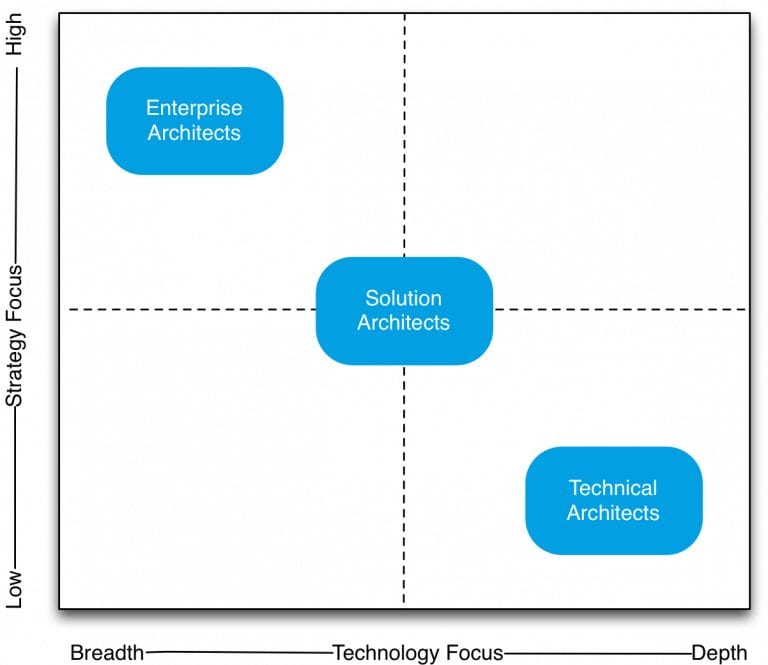In our rapidly evolving world driven by new realms, organizations feel the need to change their operating methods and techniques to face the emerging business challenges and fluctuating customer demand.
In other words, businesses need to perform the digital transformation of their core operations, which is to transfer core processes to software solutions, streamlining them. As this transition is highly complex (even separate parts of it demand close attention), every company needs an expert with a particular skill set and a knack for balancing business needs with different nuances of technology solutions.
A solutions architect is an expert and one of the most significant and client-facing roles in the IT industry, whose importance is nonetheless often overlooked or even completely ignored by companies at both ends.
For a software solution to work effectively, scale, and meet the set business needs, it needs to have a well thought out architecture that accounts for numerous technical and customer nuances. Put simply, the long-term success of any IT project relies on the input from a solutions architect, who needs to have:
- wide-ranging technical expertise
- business analysis skills
- project management skills, etc.

In this post, we will:
- explain what a solutions architect’s role is
- what their responsibilities are
- take a look at the required skillset
- how the role differs from other similar positions, as well as the average salary
- why having a solutions architect is critical for organizations and projects
Let’s start.
What Is a Solutions Architect’s Role in a Company?
A solutions architect is responsible for creating a comprehensive architecture for a software solution and providing strategic direction throughout the development process.
This person needs to ensure that the new solution fits into the existing enterprise architecture from the technical, business, user, and other perspectives.
They cooperate with all the teams involved in the development process and need to know how every product and service work in architecture. A solutions architect needs all this knowledge to oversee a successful delivery of a quality end product to its end users.
What Does a Solutions Architect Do?
Having a clear vision for the project, and a clear understanding of the client’s business needs, a solutions architect maps out the parts that will constitute the software solution and how they are going to work together.
A solutions architect starts very early in the project, laying out what is to come. Their tasks usually begin from choosing the right technology for the business problem(s) and managing architectural concerns to ensure more productive and effective outcomes.
A solutions architect is responsible for translating the vision for the project to the development team and plays a pivotal part throughout the entire systems development lifecycle. They are also involved in future updates to the solution.

Solutions Architect Responsibilities & Detailed Role Explanation
As the job title implies, a solutions architect primarily focuses on solution-level decisions and evaluation of their impact on a client’s overarching business objectives and their outcomes.
In most cases, a solutions architect’s responsibilities revolve around ensuring that the software solutions aligns with a client company’s resources, risk identification, and planning. Here are some of the main responsibilities of a solutions architect:
- Creates and leads the process of integrating IT systems for them to meet an organization’s requirements.
- Conducts a system architecture evaluation and collaborates with project management and IT development teams to improve the architecture.
- Evaluates project constraints to find alternatives, alleviate risks, and perform process re-engineering if required.
- Updates stakeholders on the status of product development processes and budgets.
- Notifies stakeholders about any issues connected to the architecture.
- Fixes technical issues as they arise.
- Analyzes the business impact that certain technical choices may have on a client’s business processes.
- Supervises and guides development teams.
- Continuously researches emerging technologies and proposes changes to the existing architecture.
Core Solutions Architect Skills
To successfully design, create, and lead the development of a software solution, a solutions architect needs to have a certain skill set.
Let’s take a closer look at the most important skills of a solutions architect below:
- Superior Communication. Being able to communicate effectively with stakeholders, project managers, developers, and software vendors involved in the software development process is essential for a solutions architect.
As the architect has a central role in any project and leads every team on it, ineffective communication can lead to big bottlenecks. So, a solutions architect should be able to clearly explain, understand everyone’s point of view, listen, advise, and influence.
- Project and Resource Management. Although a solutions architect is not directly involved in project development, they still need to ensure that project resources are being used efficiently and impactfully.
They should be business-minded, capable of identifying the most effective solution at every turn, for every part of the architecture. It is their responsibility to focus on business goals, including hiring new people, and understand how to achieve them in the set timeframe and within the given budget.
- In-depth Analysis. Software architecture and systems integrated into it are numerous details that work together. A solutions architect needs to be very attentive to those details, as overlooking something may hinder the development process, lead to breakdowns, or make the software solution inefficient.
They also should be able to understand the technical specifications of many different software solutions and hardware and perform analysis of different business layers. The solutions architect is also responsible for the project context from the very beginning to the current moment. He or she needs to remember all the details of the projects and ideas to validate and approve them on time.

- Risk Identification and Management. A solutions architect must be capable of analyzing and identifying potential short and long term risks that may cause technical issues and impede business operations in the future.
- Technical Skills. Expectedly, the role of a solution architect requires technical education and hands-on experience across all major areas of the software development process as well as hardware engineering expertise (for software projects that rely on hardware).
Thus, a solutions architect should have at least 6 to 8 years of experience in the following areas:
- Business analysis
- IT infrastructure
- Software architecture design
- Cloud development
- DevOps
Enterprise Architect Vs. Technical Architect Vs. Solutions Architect
There are three different architecture-related roles in the IT industry. Each of these roles is equally essential for the success of a project they are involved in and cannot be replaced by any other positions:
- Enterprise Architect
- Technical Architect
- Solutions Architect
Now, let’s learn more about these roles and how they differ from one another.
Enterprise Architect Vs. Solutions Architect Role
An enterprise architect is responsible for overseeing a company’s entire enterprise ecosystem. Enterprise architects focus on constructing and managing complex solutions that solve the company’s critical strategic issues.
The overarching goal of an enterprise architect is to ensure that the company has smooth development lifecycles and uses available resources for every enterprise application effectively.
Meanwhile, a solutions architect has a much more practical role. They take the business requirements and turn them into new software solutions that use a company’s emerging technology.
Technical Architect Vs. Solutions Architect Role
A technical architect chiefly oversees the software architecture, technical engineering, and implementation technology. Their main task is to provide technical leadership and make decisions regarding the most vital parts of the system that is being developed.
They work closely with development teams to communicate IT strategies and outline practices that are meant to be followed throughout the project. The main difference between a technical architect and a solutions architect these two roles is that the first focuses primarily on the engineering side.
Here’s an image that gives a general perspective on how these three roles differ:

Source: eapj.org
Solutions Architect Salary 2020
According to job search sites, the average salary for a Solutions Architect role can vary widely depending on the location, education, certifications, additional skills, the number of years in the profession, etc.
As of Jul 1, 2020, the average annual pay for an AWS Solutions Architect in the United States is $155,005 a year. This position requires at least a bachelor’s degree in computer science, information technology, or software engineering. Although experience is not always required, several years of network administration experience is beneficial.
Importance of Solutions Architect In a Company
One of the main reasons why a company should employ a solutions architect is to successfully design and develop new technology solutions that align with its business needs, as well as fill in the communication gap between technical and non-technical experts involved in an IT project.
As the process is always heavy on the budget and highly risky, every company should have a solutions architect to implement new solutions and scale them successfully. A solutions architect can be introduced to a company’s enterprise structure through software architecture consulting services.
Conclusion
A solutions architect is responsible for building and implementing IT systems architectures that meet the set business requirements. Their role starts with gathering the requirements, understanding the specifications, evaluating the systems that are in place, and working closely with stakeholders to deliver the right solution.
In general, the solutions architect’s role is to explain the business requirements to the development team and lead them in building a product that can solve real business issues effectively. The position is very responsible and requires a wide-ranging IT skillset and knowledge. With companies increasingly relying on software and emerging technologies, the role of a solutions architect will continue to gain weight.
Talk to our experts today to find out more about the topic and how your business or project can start benefiting from it!